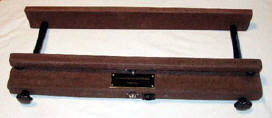Difference between revisions of "PorchBoard Floor Bass"
m (Added image with permission from Nadene at EnRoute Music.) |
m |
||
| Line 1: | Line 1: | ||
| − | [[Image:PorchBoardBass|right|PorchBoard Bass]] | + | [[Image:PorchBoardBass.jpg|right|PorchBoard Bass]] |
The Porchboard Bass™ is a simple percussive instrument designed to be tapped by a foot to provide a "kick drum"-like sound. With very little audible sound by itself, the internal pickup provides both 1/4" and XLR output connections. | The Porchboard Bass™ is a simple percussive instrument designed to be tapped by a foot to provide a "kick drum"-like sound. With very little audible sound by itself, the internal pickup provides both 1/4" and XLR output connections. | ||
Revision as of 13:04, 25 March 2008
The Porchboard Bass™ is a simple percussive instrument designed to be tapped by a foot to provide a "kick drum"-like sound. With very little audible sound by itself, the internal pickup provides both 1/4" and XLR output connections.
See the Porchboard website for more information on models available and what it looks like.
Like any instrument, when you spend some time with it you can get different effects and be more expressive with it as you learn it's capabilities & limitations (and yours!).
Here are some learnings about playing this instrument through the L1 .
- You get a different sound based on where along the tap-rail you place your foot (as well as how hard, of course). This worked well for emphasizing different beats, with softer taps being near the outside end of the rail and the louder ones nearer the middle.
- While sitting (which makes it *much* easier to use both feet!), I found it effective to place one foot over one end of the tap rail (over the support on one end) while the other foot did the tapping at various places. This acted something like a "damper" pedal/muffler, allowing me more control over how quietly I could 'tap'.
- As with many percussive instruments, you definitely get different sounds when you do a "stomp-and-leave -the-foot-on-the-rail" vs. a "quick-tap-and-get-the-foot-off-as-fast-as-you-can".
- There's no reason to just tap with just the toe or ball of your foot. You can also turn it around to place the "tap-rail" (the one with the pickup under it) under your heel, so you tap by raising your heel rather than the toe. In a lot of ways that is often a more comfortable position for me when I'm playing the keyboard (raising the heel rather than the toe). Besides that, it uses different muscles -- so when my leg is getting a bit tired, I'll sometimes turn the Porchboard around before the next song.
- One can get really quiet taps by tapping on the "fixed" rail, rather than the "tap-rail"; that is, tap so the vibration goes through the whole board to the pickup, rather than tapping on the "tap-rail" itself (which is directly over the pickup). This effect, however, may vary widely, depending on which model of the Porchboard you have.
- The most interesting range of effects is possible when the gain is high enough that you have to tap softly most of the time. Besides that, it's a lot easier on the leg when you can minimize the effort involved in playing it. Yeah, it'll often "flash red" at those higher gains if you then stomp on the 'Board, but the associated distortion can (judiciously applied) have it's own place. Besides, why should guitarists be the only ones who have fun with deliberate distortion?!?!
(Of course, for those of you who have seen Cliff Hendrickson play the keyboard, if one stuck the Porchboard under *his* foot you'd have to turn the gain waaaayyyy down! -- come to think of it, you'd really need two in order to stick one under each foot!)
- Unlike an acoustic kick drum, or most other large drums, the Porchboard seems to have few strong higher harmonics; for example, turning the High EQ way down seems to have little effect on the resulting sound.
- Also unlike an acoustic kick drum, the Porchboard has very little intrinsic sense of "pitch" -- little sense of "playing a note". What that means is that when you play it by itself, it is rather bland and boring. The good aspect of that, however, is that it will complement most anything playing along with it -- you never have to "tune it up".
- Because of producing predominately low-end sounds, it really demonstrates some of the "curses" of bass sound which Hilmar-at-Bose talks about -- such as how the volume of bass sounds can vary radically at different positions in the room. For example, at one point during an "acoustic jam", someone came up and turned down the volume a bit on the remote channel for the Porchboard, whispering to the performer "it was way too loud in the back of the room" -- but from where the performer was sitting the sound seemed to be nicely "underneath" the other folks playing.
- The best sound of the Porchboard seems to come when played through an Extended Bass L1 System (one with 4 B1 Bass Module's); four B1 Bass Module's provide the broad dynamic low range which can bring out the variety of volumes one has with most percussive instruments. However, it can also sound just fine through single or double B1 Bass Module Systems, too. However, it is not recommend for use with an L1 without at least one B1 Bass Module attached.
- Note that the pickup in the Porchboard is much like a microphone; however, since it is (usually) sitting on the floor, you might need to be careful about what other pieces of electrical devices are near it. For example, a "wall-wart" (an external power supply or transformer) next to it might cause a 60-cycle 'hum' to be amplified!
